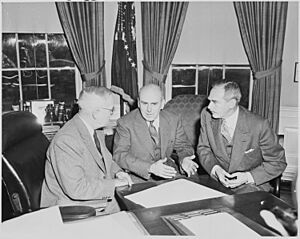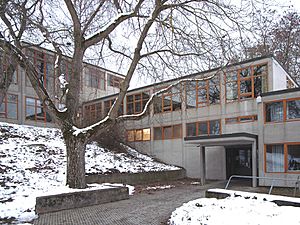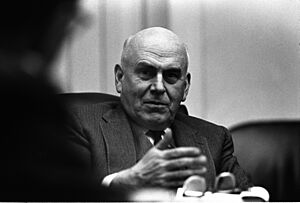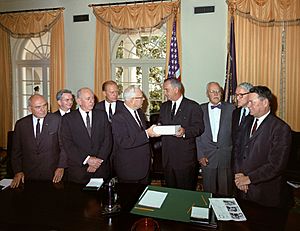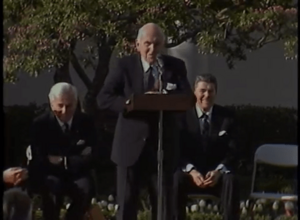John J. McCloy facts for kids
Quick facts for kids
John McCloy
|
|
|---|---|

McCloy in 1950
|
|
| Chairman of the Council on Foreign Relations | |
| In office 1953–1970 |
|
| Preceded by | Russell Cornell Leffingwell |
| Succeeded by | David Rockefeller |
| American High Commissioner for Occupied Germany | |
| In office September 21, 1949 – August 1, 1952 |
|
| President | Harry Truman |
| Preceded by | Position established |
| Succeeded by | Walter J. Donnelly |
| 2nd President of the World Bank Group | |
| In office March 17, 1947 – June 30, 1949 |
|
| Preceded by | Eugene Meyer |
| Succeeded by | Gene Black |
| United States Assistant Secretary of War | |
| In office April 22, 1941 – November 24, 1945 |
|
| President | Franklin D. Roosevelt Harry S. Truman |
| Preceded by | Robert P. Patterson |
| Succeeded by | Howard C. Petersen |
| Personal details | |
| Born |
John Snader McCloy
March 31, 1895 Philadelphia, Pennsylvania, U.S. |
| Died | March 11, 1989 (aged 93) Cos Cob, Connecticut, U.S. |
| Political party | Republican |
| Spouse |
Ellen Zinsser
(m. 1930; died 1986) |
| Children | 2 |
| Education | Amherst College (BA) Harvard University (LLB) |
| Awards | |
John Jay McCloy (March 31, 1895 – March 11, 1989) was an important American lawyer, diplomat, and advisor to many presidents. He played a big role in shaping the United States' foreign policy for over 40 years.
McCloy was known as one of "The Wise Men". This was a group of respected leaders who believed in working with other countries. They focused on practical solutions rather than strong political ideas.
Contents
Early Life and Education
John McCloy was born in Philadelphia, Pennsylvania, in 1895. His father passed away when John was five years old. His mother worked as a hairdresser.
McCloy often said his family was poor. He felt like an outsider growing up. He later changed his name to "John Jay McCloy" to sound more formal.
He went to Peddie School in New Jersey. Then he attended Amherst College, graduating in 1916. He was a good student and enjoyed playing tennis.
In 1930, McCloy married Ellen Zinsser. They had two children, John J. McCloy II and Ellen Z. McCloy.
World War I Service
McCloy started at Harvard Law School in 1916. When the United States joined World War I in 1917, he joined the United States Army. He became a second lieutenant in the Artillery.
He served in France with the American Expeditionary Forces. He fought in the Meuse–Argonne offensive. After the war, he was promoted to captain. He left the army in 1919 and finished his law degree in 1921.
A Career on Wall Street
After law school, McCloy worked for top law firms in New York City. He handled cases for many wealthy clients.
One important case involved the 1916 Black Tom explosion. This was when German agents sabotaged a munitions factory in New Jersey. McCloy found new evidence to reopen the case against Germany. This work made him very interested in intelligence and German affairs.
By 1940, McCloy was earning a lot of money as a lawyer. He had also saved a good amount.
World War II Leadership
In 1940, Henry Stimson, the US Secretary of War, hired McCloy. Stimson was impressed by McCloy's knowledge of German sabotage. He knew Germany might try to attack American facilities again.
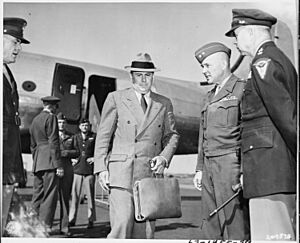
On April 22, 1941, McCloy became Assistant Secretary of War. He managed civilian tasks like buying war supplies. He also handled intelligence and sabotage issues. He played a key role in many important wartime decisions.
Building Security Agencies
During the war, McCloy was part of many important groups. He helped plan the Pentagon building. He also helped create the Office of Strategic Services. This agency later became the Central Intelligence Agency (CIA).
He also suggested creating the United Nations and the war crimes trials. He led the group that later became the United States National Security Council.
Japanese-American Internment
In 1942, McCloy was involved in the decision to move Japanese-Americans from their homes. They were sent to internment camps inland. The President had given this task to McCloy through Secretary Stimson.
Some military leaders believed this was needed to prevent sabotage. However, the Office of Naval Intelligence disagreed. They said most Japanese-Americans suspected of spying were already being watched.
The Supreme Court first supported these actions. But later, judges changed their minds. Years later, the convictions of Japanese-Americans were overturned. This was because the government had hidden important information. The court found that the orders were based on racism, not military need.
Decision on Auschwitz Bombing
During 1944, some people asked the War Department to bomb the railway lines leading to Auschwitz. They also asked to bomb the gas chambers there. McCloy responded that this was not practical.
He said it would take too many planes away from important military operations. He also thought it would not be very effective. The Army Air Forces did not want outside groups choosing their targets. President Roosevelt also rejected these ideas.
Saving Rothenburg ob der Tauber
In March 1945, American troops were fighting in Germany. The historic town of Rothenburg ob der Tauber was being defended by German soldiers. McCloy knew how beautiful and important Rothenburg was.
He ordered US Army General Jacob L. Devers not to use artillery on the town. An American officer, Frank Burke, sent six soldiers to negotiate. They told the German commander that the town would be bombed if they didn't surrender. The German commander ignored Hitler's order to fight to the end. He surrendered the town, saving it from destruction.
In 1948, McCloy was made an honorary citizen of Rothenburg.
Ending the War with Japan
By mid-1945, McCloy tried to convince President Truman not to invade Japan. He knew that the Japanese emperor was looking for a way to surrender. The emperor wanted to keep the Japanese monarchy.
McCloy advised Truman to offer surrender terms that included this guarantee. He also suggested hinting at the use of the atomic bomb. He believed this would give the US a moral advantage. However, Truman decided to drop the atomic bombs as soon as they were ready.
Ending Segregation in the Military
McCloy was the head of the Army's Advisory Committee on Negro Troop Policy. At first, he did not support ending segregation in the Army. But he changed his mind.
In late 1945, he suggested ending segregation in the military. This was before he left the government.
After the War
Leading the World Bank
From 1947 to 1949, McCloy was the second president of the World Bank. This organization was new and had faced problems. McCloy helped fix these issues.
He worked with Wall Street to get money for projects in other countries. He sold hundreds of millions of dollars in bonds. McCloy left the World Bank when the Marshall Plan started. The Marshall Plan provided much more money to help Allied countries rebuild.
US High Commissioner for Germany
In 1949, McCloy became the first US High Commissioner for Germany. He held this job until 1952. He helped create the Federal Republic of Germany.
McCloy made some controversial decisions. He approved reducing the sentences of some Nazi criminals. This included Alfried Krupp, a powerful industrialist. He also returned Krupp's property. He also reduced the sentence of Ernst von Weizsäcker at the request of Winston Churchill.
However, McCloy refused to pardon five men he called "the worst of the worst." These men were executed in 1951. There were huge protests in West Germany about this.
McCloy also supported the creation of the Ulm School of Design. This school is considered one of the most important design schools after the Bauhaus. McCloy saw it as a very important project. In 1952, he gave the school one million Deutschmarks.
Return to Wall Street and Advising Presidents
After his time in Germany, McCloy became chairman of the Chase Manhattan Bank from 1953 to 1960. He also chaired the Ford Foundation from 1958 to 1965.
From 1954 to 1970, he was chairman of the Council on Foreign Relations. He had a long connection with the Rockefeller family. He even taught the young Rockefeller brothers how to sail.
McCloy advised many US presidents. These included John F. Kennedy, Lyndon Johnson, Richard Nixon, Jimmy Carter, and Ronald Reagan. He was also the main negotiator for the Presidential Disarmament Committee.
Warren Commission
In 1963, President Lyndon Johnson chose McCloy to serve on the Warren Commission. This group investigated the assassination of President John F. Kennedy.
McCloy was initially unsure about the "lone gunman" theory. But after visiting Dallas, he became convinced that Lee Harvey Oswald acted alone. He helped write the final report. He stated that any evidence of a conspiracy was "beyond the reach" of all US agencies. He later said he never saw a case more completely proven. He called conspiracy theories "just nonsense."
McCloy became a partner in a famous New York law firm. He worked there for 27 years until his death. He was sometimes called the "Chairman of the American Establishment" because of his influence.
Death
John McCloy passed away on March 11, 1989, at his home in Cos Cob, Connecticut. He was 93 years old.
Legacy
McCloy served under presidents from both political parties. Even though he was a Republican, he held a very high position in the War Department during World War II. Like the other "Wise Men," McCloy often left his well-paying jobs to serve his country.
He is also remembered for helping create the Central Intelligence Agency (CIA). He helped combine different intelligence groups into one. This became a model for the CIA.
McCloy received many awards for his service. President Lyndon B. Johnson gave him the Presidential Medal of Freedom with Distinction in 1963. He also received the Sylvanus Thayer Award from the United States Military Academy.
On his 90th birthday, he was named an honorary citizen of Berlin. President Ronald Reagan praised McCloy for his dedication to duty and humanity. The award recognized McCloy's help in rebuilding Berlin and promoting peace and freedom.
See also
 In Spanish: John J. McCloy para niños
In Spanish: John J. McCloy para niños
- Chase Manhattan Bank
- Council on Foreign Relations
- Japanese American internment
- McCloy–Zorin Accords
- Milbank, Tweed, Hadley & McCloy
- David Rockefeller
- Rockefeller family
- The World at War - "The Bomb"
- World Bank



